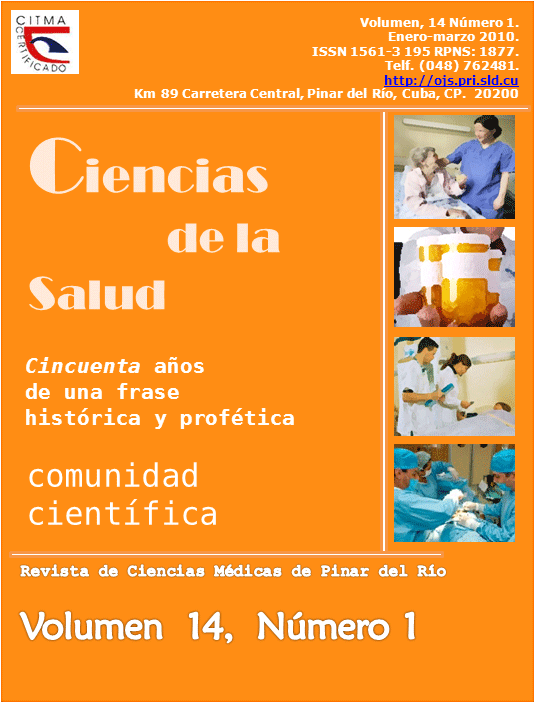Clinical and epidemiological aspects of ischemic heart disease in San Juan y Martinez, 2009
Abstract
Ischemic Heart Disease is a health problem that takes a great number of lives off and it is a cause of disability all over the world. The objective of this research was to identify clinical and epidemiological aspects that characterize ischemic heart disease in 150 patients (15 years or older), belonging to three doctor's offices in the Popular Council of "Galope", San Juan y Martinez, Pinar del Rio during January-July 2009. This place presents the greatest incidence and prevalence in the municipality. A descriptive and cross-sectional research was conducted including questioning, physical examination and electrocardiogram to the total of the sample chosen. Data were processed using percentage value and chi square when necessary. In the sample male sex prevailed over the female, and ages older than 56 in both groups. Ischemic heart disease without angina was the prevailing clinical manifestation; meanwhile alterations of the ST-segment were the most common electrocardiographic findings. Smoking, sedentary life and hypertension were the most frequent risk factors in the series, increasing with age and all of them prevailed in the group suffering from ischemic heart disease significantly. A direct relationship between risk factors associated and ischemic heart disease was found.Downloads
References
1. Hernández Cisneros F, Mena Lima AM, Rivero Sánchez M, Serrano González A. Hipertensión arterial: comportamiento de su prevalencia y de algunos factores de riesgo. Rev Cubana Med Gen Integr 1996; 12(2):145-9.
2. Moreno Maura P: Cardiopatia Isquémica, factores de riesgo coronario. Archivo Médico de Camagüey[revista en internet], 2000 [citado Sept 2008]; 4(3): Disponible en: http://www.amc.sld.cu/amc/2000/v4n3/346.htm
3. Oneil BJ. Cardiac makers' protocols in a chest pain obsrvation unit. Emerg Med clin North Am .2008; 19(1): 67-68.
4. Cruz Bañobre A y col: Diagnóstico no invasivo de isquemia silente en pacientes con factores de alto riesgo coronario. Rev Cubana Med[revista en internet]. 2001 [citado]; 40(4):p.235-42. Disponible en: http://bvs.sld.cu/revistas/med/vol40_4_01/med01401.htm
5. Pereira García Ana B, Inufia Suárez Regina, Prado María I, Rodríguez Sarah, de los Santos Nicolás, Dueñas Fernández Raúl. Factores de riesgo coronario relacionado con alteraciones ergométricas y electrocardiogréficas, septiembre de 1992 a mayo de 1993. Rev Cubana Enfermer [revista en la Internet]. 1995 Ago [citado 2008 Dic 13]; 11(2): 5-6. Disponible en: http://scielo.sld.cu/scielo.php?script=sci_arttext&pid=S0864-03191995000200003&lng=es
6. Hernández Ruiz JL, Hernández Muñozuri J, Almazán Soo A, Ramos, García MA, Solorio S. Electrofisiología y marcapasos. Rev Mex Cardiol [revista en internet]. Septiembre 2002[citado]; 13 (3): 86-124 Disponible en: http://medigraphic.com/espanol/e-htms/e-cardio/e-h2002/e-h02-3/em-h023a.htm
7. Azpitarte Cabadés A: Angina de Pecho. Concepto y clasificación. Rev Esp Cardiol. 2008; 48:373-382.
8. Infante García O: Valoración de un nuevo método para el análisis de lso componentes espectrales del complejo QRS. Inst Cardiol Mex .2006; 66(2): 98-115.
9. Rosas Peralta M y col: Electrocardiografía de alta fidelidad para el diagnóstico de cardiopatía Isquémica. Arch. Inst. Cardiol. Méx. abr. 1996; 66(2):98-115. Disponible en: http://bases.bireme.br/cgi-bin/wxislind.exe/iah/online/?IsisScript=iah/iah.xis&src=google&base=LILACS&lang=p&nextAction=lnk&exprSearch=180414&indexSearch=ID
10. Pimentel Fernández C: Hallazgos electrocardiográficos de pacientes con cardiopatía Isquémica. Lima; 2005.Pp58.
11. Romero Doger M y col: Estudio de la prevalencia de enfermedades de origen aterosclerótico de un area de salud. Rev. cub. med. gen. Integr. jun. 1992; 8(2):127-38.
12. Martínez Peralta M. Angina de pecho inestable en Caballero Tratado de Medicina Interna .2006.Pp.1123-1142.
Published
How to Cite
Issue
Section
License
Authors who have publications with this journal agree to the following terms: Authors will retain their copyrights and grant the journal the right of first publication of their work, which will be publication of their work, which will be simultaneously subject to the Creative Commons Attribution License (CC-BY-NC 4.0) that allows third parties to share the work as long as its author and first publication in this journal are indicated.
Authors may adopt other non-exclusive license agreements for distribution of the published version of the work (e.g.: deposit it in an institutional telematic archive or publish it in a volume). Likewise, and according to the recommendations of the Medical Sciences Editorial (ECIMED), authors must declare in each article their contribution according to the CRediT taxonomy (contributor roles). This taxonomy includes 14 roles, which can be used to represent the tasks typically performed by contributors in scientific academic production. It should be consulted in monograph) whenever initial publication in this journal is indicated. Authors are allowed and encouraged to disseminate their work through the Internet (e.g., in institutional telematic archives or on their web page) before and during the submission process, which may produce interesting exchanges and increase citations of the published work. (See The effect of open access). https://casrai.org/credit/



